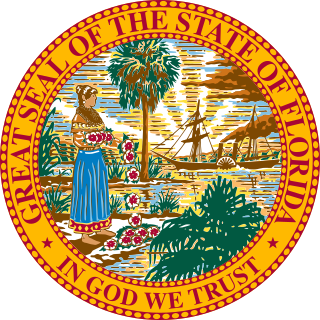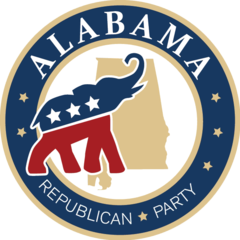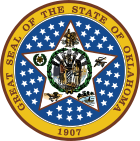
The Democratic Party of Hawaiʻi is the affiliate of the Democratic Party in the state of Hawaii.

The Kansas Republican Party is the state affiliate political party in Kansas of the United States Republican Party. The Kansas Republican Party was organized in May 1859.

The Florida Democratic Party is the affiliate of the Democratic Party in the U.S. state of Florida, headquartered in Tallahassee. Former Commissioner of Agriculture Nikki Fried is the current chair.
The Maryland Republican Party is the Maryland state branch of the Republican Party (GOP), headquartered in Annapolis. It is the state's minority party, controlling no statewide offices, minorities in both houses of the state legislature, and 1 of 8 U.S. House seats.
The Democratic Party of Wisconsin is the affiliate of the Democratic Party in the U.S. state of Wisconsin. It is currently headed by chair Ben Wikler.

The Utah Republican Party is the affiliate of the Republican Party in the U.S. state of Utah. It is currently the dominant party in the state, and has been for almost all of its history. It currently holds Utah's entire congressional delegation, all statewide executive offices, and supermajorities in both state legislative chambers.

The results of elections in the state of New York have tended to be more Democratic-leaning than in most of the United States, with in recent decades a solid majority of Democratic voters, concentrated in New York City and some of its suburbs, including Westchester County, Rockland County and Long Island's Nassau county, and in the cities of Buffalo, Rochester, Syracuse, Albany, and Ithaca.

The politics of Oklahoma exists in a framework of a presidential republic modeled after the United States. The governor of Oklahoma is both head of state and head of government, and of a pluriform two-party system. Executive power is exercised by the governor and the government. Legislative power is vested in the governor and the bicameral Oklahoma Legislature. Judicial power is vested in the judiciary of Oklahoma. The political system is laid out in the 1907 Oklahoma Constitution.

The Oklahoma Republican Party is an Oklahoma political party affiliated with the Republican Party. Along with the Oklahoma Democratic Party, it is one of the two major parties in the state.

The Nebraska Democratic Party is the affiliate of the Democratic Party in the state of Nebraska. Over 700 Democrats are elected across the state of Nebraska. Jane Kleeb is the chair of the Nebraska Democratic Party and also serves as the Midwest Chair of the Association of State Democratic Committees.

The Democratic Party of Oregon is the Oregon affiliate of the Democratic Party. The State Central Committee, made up of two delegates elected from each of Oregon's 36 counties and one additional delegate for every 15,000 registered Democrats, is the main authoritative body of the party. The party has 17 special group caucuses which also each have representation on the State Central Committee.

The Alaska Democratic Party is the affiliate of the Democratic Party in Alaska, headquartered in Anchorage.
The Delaware Democratic Party (DelDems) is the affiliate of the Democratic Party in the U.S. state of Delaware. It is headquartered in New Castle County and chaired by Erik Raser-Schramm.

The Kentucky Democratic Party is the affiliate of the Democratic Party in the U.S. state of Kentucky. It is currently the minority party in the state, as the rival Republican Party of Kentucky overwhelmingly dominates in the state legislature, congressional delegation, and presidential elections. However, the party does currently control the governorship and lieutenant governorship, and maintains some strength in local elections.
The Louisiana Democratic Party is the affiliate of the Democratic Party in the state of Louisiana.

The West Virginia Democratic Party is the affiliate of the Democratic Party in the U.S. state of West Virginia.

The Alabama Republican Party is the state affiliate of the Republican Party in Alabama. It is the dominant political party in Alabama. The state party is governed by the Alabama Republican Executive Committee. The committee usually meets twice a year. As of the February 23, 2019 meeting in Birmingham, the committee is composed of 463 members. Most of the committee's members are elected in district elections across Alabama. The district members are elected in the Republican Primary once every four years, with the most recent election for the committee having been on June 5, 2018. The new committee takes office following the general election in November 2018. In addition, all 67 county GOP chairmen have automatic seats as voting members. The state chairman can appoint 10 members. Each county committee can appoint bonus members based on a formula that theoretically could add 312 seats, although that formula currently calls for only about 50 seats.

The Maine Republican Party is an affiliate of the United States Republican Party in Maine. It was founded in Strong, Maine, on August 7, 1854. The party currently does not control the governor's office or either chamber of the Maine Legislature, nor either of Maine's two U.S. House seats and only controls one of the state's U.S. Senate seats.
Washington ratified its constitution and held its first state elections in 1889, the year it was admitted to the union as a state. It established the positions of governor, lieutenant governor, Secretary of State, attorney general, state treasurer, state auditor, Commissioner of Public Lands, and Superintendent of Public Instruction. The position of insurance commissioner was legislatively established in 1907. All positions are elected to four-year terms, concurrent with presidential elections. Washington is one of three states that elects nine separate statewide officials, while six others elect ten.

The Government of Mississippi is the government of the U.S. state of Mississippi. Power in Mississippi's government is distributed by the state's Constitution between the executive and legislative branches. The state's current governor is Tate Reeves. The Mississippi Legislature consists of the House of Representatives and Senate. Mississippi is one of only five states that elects its state officials in odd numbered years. Mississippi holds elections for these offices every four years in the years preceding Presidential election years.




































